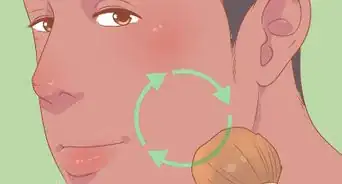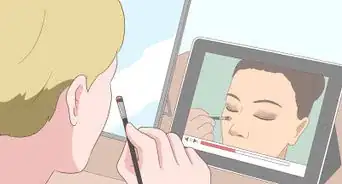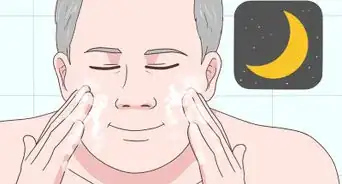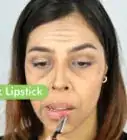This article was co-authored by Katya Gudaeva and by wikiHow staff writer, Amber Crain. Katya Gudaeva is a Professional Makeup Artist and the Founder of Bridal Beauty Agency based in Seattle, Washington. She has worked in the beauty industry for over 10 years and worked with companies such as Patagonia, Tommy Bahama, and Barneys New York and with clients such as Amy Schumer, Macklemore, and Train.
There are 8 references cited in this article, which can be found at the bottom of the page.
This article has been viewed 88,841 times.
Stage makeup is a little bolder than your everyday makeup look. The extra definition prevents your facial features from being washed out by the bright stage lights and ensures your face can be seen from a distance. Start with a full-coverage foundation, concealer, and blush, and set the makeup with a dusting of translucent powder. Define your eyebrows and accentuate your eyes with eyeshadow, eyeliner, and mascara. Finish your look by applying bright red or pink lipstick, depending on the character you’re playing. Don’t forget to remove your makeup thoroughly after the show to prevent breakouts!
Steps
Foundation and Contour
-
1Wash and moisturize your face to create a smooth base for makeup. Use warm water and a mild cleanser to wash your face. Rinse your skin thoroughly and pat it gently with a towel to dry it. Then, apply an oil-free moisturizer all over your face and give it a few minutes to soak in before proceeding.[1]
- If your skin is dry or flaky, consider gently exfoliating after you cleanse or use an exfoliating cleanser to slough away rough patches.
Tip: Apply a toner in between your cleanser and moisturizer for a pore-tightening effect.
-
2Use a sponge or makeup brush to apply oil-free foundation.[2] Go with a full coverage liquid foundation that matches your skin tone or that’s one shade darker than your skin tone. Apply the foundation all over your face to even out your skin tone and give you a nice base to work on. Be sure to blend out thoroughly at the hairline and jawline.[3]
- If you have warm or reddish undertones, look for a foundation with a yellow or golden finish. If your character is supposed to be sick or tired, go with a foundation that has cool undertones.
- Consider applying primer before foundation. It’s not required, but it can help makeup last longer, especially under the hot stage lights.
Advertisement -
3Apply concealer to cover up undereye circles and blemishes.[4] For dark circles, use a peachy concealer to color correct the purple under your eyes, then follow it up with a concealer that matches your foundation. Then, dot concealer onto blemishes individually with your finger or a makeup brush and blend it out for a seamless look.[5]
- If you don’t have dark circles or blemishes, you don’t need to use concealer.
-
4Set your foundation and concealer with translucent powder. Use a fluffy powder brush to apply a light dusting of translucent powder all over your face. A light dusting is all you need to set the foundation and concealer and mattify any areas that look oily.[6]
- Mattifying is important, since you don’t want your face to look shiny under the stage lights.
-
5Contour and highlight your face for extra definition, if desired. Apply bronzer that’s 1-2 shades darker than your foundation to your cheekbones, temples, and jawline to define those features. Use a fluffy brush to blend the bronzer seamlessly into the foundation. Then, apply a highlighting powder or cream that’s 1-2 shades paler than your foundation to your brow bones and along the top of your cheekbones. Be sure to feather out any harsh lines with a fluffy blush to blend your highlighter into the rest of your makeup.[7]
-
6Apply blush to your cheeks to accentuate your cheekbones. Use a fluffy brush to apply powdered blush to each cheekbone, starting on the apple of each cheek, which is usually directly under the center of your eyes. Then, sweep the color along your cheekbones and blend out at the hairline to get rid of any harsh lines.[10]
- Use a blush color that complements your skin tone. Peachy blushes tend to look good on warm undertones, and pinks and roses complement cool undertones.
Eyes and Lips
-
1Fill in your eyebrows with a matching brow powder or pencil. Eyebrows can get lost under stage lights, so it’s important to emphasize them. Use a small makeup brush to fill in your natural brows with brow powder that matches the color of your natural brows, or use a matching eyebrow pencil to fill them in. Create a gentle arch at the highest point of your natural brow, which helps to frame your facial features.[11]
- If you’re blond, use a light or medium brown pencil or brow powder to fill in your brows to ensure they show up from a distance.
- To further define your eyebrows, you can apply a white eyeliner or cream directly beneath each eyebrow, which will provide a sharp contrast. Be sure to blend the makeup well so that you don't have a harsh white line.[12]
-
2Apply neutral eyeshadow to give your eyes dimension. Select three shadows: a cream color, a light brown, and a medium to dark brown. Use a makeup brush to apply the medium shade all over both lids and slightly over the crease. Use the lightest color to highlight directly under the eyebrows. Apply the darkest color to your crease and sweep it out to the edge of your sockets.[13]
- If you need to create a wide-eyed look, skip the darker colors and just use the lightest eyeshadow all over your lids. To make your eyes look smaller, apply only the darkest color from your eyelashes to your crease.
- You don’t have to use eyeshadow primer before applying eyeshadow, but it can help your eyeshadow last longer.
Tip: Avoid shimmery and glittery eyeshadow, since these don't work well under stage lights. Use matte formulas for the best results.
-
3Apply eyeshadow in brighter colors if your role calls for it. Basic stage makeup usually means a neutral eye palette, but if you're playing a dramatic or colorful role, consider using brighter eyeshadow colors instead. Choose a light, medium, and dark variation of the same color and apply the eyeshadow the same way you'd apply neutrals.
- Blues and greens are good choices for dramatic or colorful characters.
- For a more sinister vibe, try a deep berry color.
-
4Accentuate your eyes with dark brown pencil eyeliner. Start at the inner corner and draw a thin line along your lash line to the outer edge of each eye. Stay as close to the lash line as possible! Then, draw a thin line along your bottom lashes for further definition.[14]
- Waterproof formulas will hold up the best on stage.
- For dramatic roles, use thick black eyeliner to accentuate your eyes.
- Use a liquid liner on your upper lash line if you want more definition.
-
5Apply 1-2 coats of dark brown or black mascara to the upper lashes. Place the mascara wand at the base of your lashes and sweep up, wiggling the wand slightly as you pull it through your lashes. This helps to coat the lashes as liberally as possible. If you want to emphasize your eyes even more, apply a second coat of mascara to your upper lashes.
- Use a waterproof formula to prevent your mascara from running on stage.
- You can also apply false eyelashes if you want your eyes to really pop.[15]
- Applying mascara to the lower lashes can make eyes look smaller, so it’s usually best to skip it.
-
6Outline your lips with a red or pink lip liner. You don’t need to overdraw your lips! Stick to your natural lip line and outline your mouth with the lip liner. What color you use really depends on your role and your studio’s preference. Pinks usually work best for younger roles, while reds work best for older and more dramatic roles.[16]
- Pick the shade that makes the most sense for your specific character.[17]
-
7Fill in your lips with a matching lipstick color. Stick to brighter reds and pinks, since darker shades can look black from a distance. Fill in both the top and bottom lips with the lipstick formula of your choice. Look for long-wearing matte formulas. Shiny finishes aren’t recommended for the stage, since the shine can create a glare under stage lights.[18]
- Cream formulas work well for dry lips. Liquid matte formulas have great staying power, but can be drying. Choose the lipstick that works best for you![19]
Tip: It's best to avoid wearing glitter finishes, shimmers, and lip gloss on top of your lipstick when you're on stage.
Setting and Removing
-
1Mist your face with setting spray or powder to lock your look in place. Setting sprays can prevent your makeup from melting and running under the hot stage lights. If you don’t have setting spray on hand, give your face another all-over dusting with your loose translucent powder to set your makeup and mattify your face.[20]
- If you need to, you can also powder your face in between scenes to prolong your stage makeup.
-
2Remove your makeup after the performance. Don’t forget to remove your makeup after the show, no matter how tired you are![21] Cream and oil-based makeup remover formulas tend to work best, but if you have super oily skin, you can use something oil-free. Soak a cotton pad with makeup remover and wipe your face thoroughly until your makeup is gone.
-
3Use a mild cleanser and moisturizer after removing your makeup. Follow up the removal product with a mild cleanser to rinse away any lingering makeup residue. Use warm water and be sure to pat your skin gently with a towel to dry it. Then, apply your favorite moisturizer all over your face to keep your skin looking supple and healthy.
- If you're prone to acne, consider using an over-the-counter benzoyl peroxide cleanser.
Expert Q&A
-
QuestionDo I need to wash off my stage makeup after each show?
 Katya GudaevaKatya Gudaeva is a Professional Makeup Artist and the Founder of Bridal Beauty Agency based in Seattle, Washington. She has worked in the beauty industry for over 10 years and worked with companies such as Patagonia, Tommy Bahama, and Barneys New York and with clients such as Amy Schumer, Macklemore, and Train.
Katya GudaevaKatya Gudaeva is a Professional Makeup Artist and the Founder of Bridal Beauty Agency based in Seattle, Washington. She has worked in the beauty industry for over 10 years and worked with companies such as Patagonia, Tommy Bahama, and Barneys New York and with clients such as Amy Schumer, Macklemore, and Train.
Professional Makeup Artist Yes. You should always remove your makeup before going to bed, or even when you get home if you're okay wearing no makeup at home. Your skin is an organ, and it needs to breathe.
Yes. You should always remove your makeup before going to bed, or even when you get home if you're okay wearing no makeup at home. Your skin is an organ, and it needs to breathe. -
QuestionWhat makeup is good for sensitive skin - especially the eyes?
 Community AnswerUse eye shadow with vitamin E in it. It soothes the eye.
Community AnswerUse eye shadow with vitamin E in it. It soothes the eye. -
QuestionWhat is the equipment used when applying basic makeup?
 Community AnswerYou can use eyeliner, lipstick and some foundation or powder. Other than that, you might need a mirror and a brush.
Community AnswerYou can use eyeliner, lipstick and some foundation or powder. Other than that, you might need a mirror and a brush.
Warnings
- Always remove your makeup after your performance to prevent breakouts and other skin issues.⧼thumbs_response⧽
- You may want to talk to your studio before you get started with makeup application. Some studios may have specific instructions or looks that they want.[25]⧼thumbs_response⧽
Things You'll Need
- Full coverage liquid foundation
- Liquid or stick concealer
- Sponges and a variety of makeup brushes
- Setting powder
- Powdered blush
- Eyebrow pencil
- Pencil or liquid eyeliner
- Black or dark brown mascara
- Neutral eyeshadow palette
- Red or pink lip liner
- Red or pink lipstick
- Makeup remover
- Cotton pads
- Mild cleanser
- Moisturizer
References
- ↑ https://www.liveabout.com/stage-makeup-101-2638558
- ↑ Katya Gudaeva. Professional Makeup Artist. Expert Interview. 11 April 2019.
- ↑ http://www.crestwestwood.com/2017/08/11/how-to-apply-theatrical-makeup-to-impress-audience/
- ↑ Katya Gudaeva. Professional Makeup Artist. Expert Interview. 11 April 2019.
- ↑ https://www.youtube.com/watch?v=Jjk9gDS8rxg&feature=youtu.be&t=93
- ↑ https://www.youtube.com/watch?v=Jjk9gDS8rxg&feature=youtu.be&t=131
- ↑ https://www.liveabout.com/stage-makeup-101-2638558
- ↑ https://www.youtube.com/watch?v=Jjk9gDS8rxg&feature=youtu.be&t=139
- ↑ https://www.pointemagazine.com/basic-training-2412799063.html
- ↑ http://www.crestwestwood.com/2017/08/11/how-to-apply-theatrical-makeup-to-impress-audience/
- ↑ https://www.liveabout.com/stage-makeup-101-2638558
- ↑ https://www.pointemagazine.com/basic-training-2412799063.html
- ↑ http://www.crestwestwood.com/2017/08/11/how-to-apply-theatrical-makeup-to-impress-audience/
- ↑ http://www.crestwestwood.com/2017/08/11/how-to-apply-theatrical-makeup-to-impress-audience/
- ↑ https://www.pointemagazine.com/basic-training-2412799063.html
- ↑ https://www.liveabout.com/stage-makeup-101-2638558
- ↑ http://www.crestwestwood.com/2017/08/11/how-to-apply-theatrical-makeup-to-impress-audience/
- ↑ https://www.pointemagazine.com/basic-training-2412799063.html
- ↑ Katya Gudaeva. Professional Makeup Artist. Expert Interview. 11 April 2019.
- ↑ http://www.crestwestwood.com/2017/08/11/how-to-apply-theatrical-makeup-to-impress-audience/
- ↑ Katya Gudaeva. Professional Makeup Artist. Expert Interview. 11 April 2019.
- ↑ https://www.liveabout.com/stage-makeup-101-2638558
- ↑ Katya Gudaeva. Professional Makeup Artist. Expert Interview. 11 April 2019.
- ↑ https://www.liveabout.com/stage-makeup-101-2638558
- ↑ https://www.youtube.com/watch?v=Jjk9gDS8rxg&feature=youtu.be&t=19

-Step-8.webp)
-Step-9.webp)
-Step-10.webp)


















































